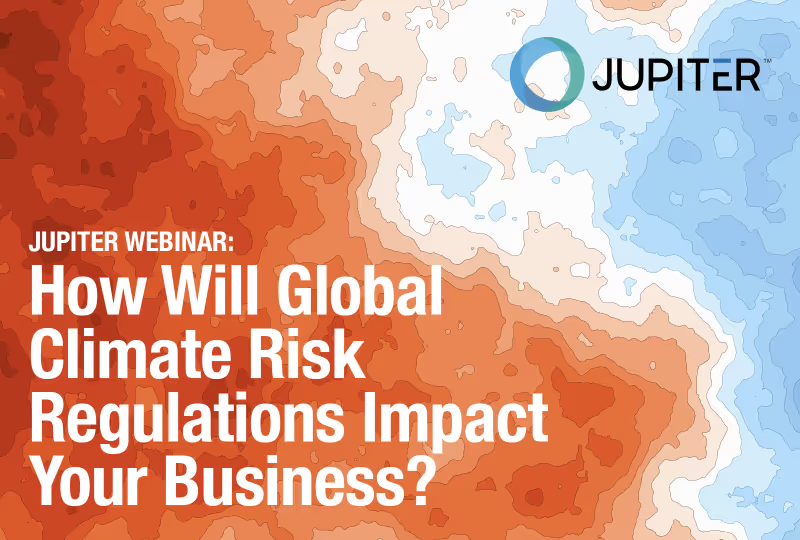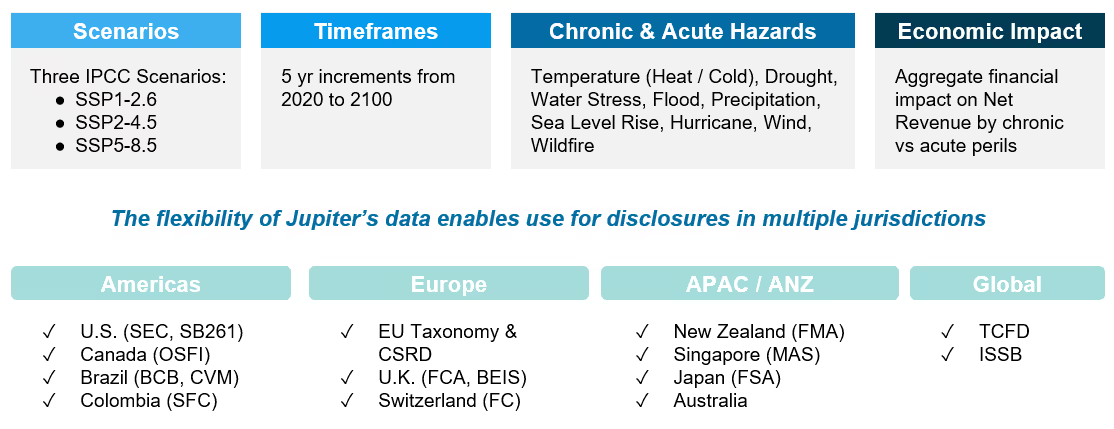
Megan Arnold, Regulatory Intelligence Manager, Jupiter
Elisa Seith, Solutions Architect, Jupiter
As the world’s largest economies move towards formulation of jurisdiction-specific guidance prescribing how organizations must assess, disclose, and report financial and operational risk from climate change, data and methods have emerged that help your company prepare for the mandates to come. Our on-demand Jupiter webinar explains why.
The Unrelenting, Complex Advance of Climate Reporting
Eight of the world’s ten biggest economies have established, or are actively planning, regulations that compel organizations that are based or do significant business in their territories to report climate-related risk to their operations and balance sheets.
This expanding global environment of new and proposed regulations often causes confusion for the reporting parties.
National, multinational, and even state regulators are developing or evolving their own mandates, moving at different speeds, and focusing on different sectors and company sizes. Some have adopted the reporting framework from the Task Force on Climate-Related Financial Disclosure (TCFD); others are “aligning” with TCFD—with some jurisdiction-related modifications. Some regulations demand reporting this year; most are expected to come into effect by the end of Fiscal 2025.
Where Things Really Stand—And What You Can Do—Today
Our webinar How Will Global Climate Risk Regulations Impact Your Business? is designed to help you find a clearer path through the labyrinth of growing and changing climate risk regulation across the world. It’s available for streaming on-demand and contains both detailed analysis and a lively Q&A session.
The first part of the webinar presents a concise, up-to-date overview, country-by-country, of existing and proposed regulations; the sectors and company sizes that are impacted; and expected deadlines for reporting. We discuss differences across regions, and how these regulations are expected to be expanded and implemented over the coming years.
We discuss the most influential reporting frameworks: TCFD, ISSB (from the International Sustainability Standards Board and the IFRS Foundation), and CSRD (the EU’s Corporate Sustainability Reporting Directive).

We also identify the common building blocks for these frameworks: their common foundational principles; their call to focus on both physical and transition risk and acute and chronic physical climate perils; and the importance of climate-risk scenario analysis.
The overview includes a deep dive that updates the evolving guidelines prescribed by one of the earliest adopters of climate regulation, the European Union. The EU has launched a comprehensive, multi-phased roll-out of mandatory climate risk and sustainability disclosures under the European Green Deal, with the main focus being placed on the EU Taxonomy and the Corporate Sustainability Reporting Directive. This new mandatory ESG reporting expands the scope by more than three times to companies in and outside the EU, so all multinational organizations who do business in this USD $18 trillion economy must understand if, when, and what they will be called upon to report.
Taking Action: Tools and Processes You Can Use

The webinar’s second part offers a pathway for companies to begin the process of complying with regulations, and for improving their financial and operational resilience to climate risk.
It discusses in some detail the solutions that companies have at their fingertips today to help them to meet regulatory requirements and begin their climate resilience journey, especially:
- Forward-focused, high-resolution physical climate risk analysis—from companies such as Jupiter Intelligence—that are based on the best available climate science.
- Emerging processes that organizations are using to identify, assess, and project the impacts of climate-related events on their assets and supply chains, and model the potential consequences of the changing climate to their financial performance.

Three Steps That Move You Forward
The major takeaway from the webinar is this: if you do business in any of the world’s most advanced economies where regulators have implemented climate risk disclosure mandates—or plan to do so—there is no time to waste.
You can take three tangible steps to get started or gain momentum in your efforts.
- Be Informed. Stay abreast of regulations, whether they’re in place or under consideration, that might impact your company, its industry, and its operations in both its native jurisdictions and international branches and subsidiaries.
- Prepare Early. Collect data on your organization’s assets (including precise geographic locations) and economic activities that you may need to report on in the respective regulation(s). Based on your industry sector and asset lifespans, identify the scenarios and time horizons—five years? thirty years? fifty years? — that you need to report on. Which climate hazards are most critical to assets at risk? Communicate with other teams across your organization, get the internal information you need, and consider aligning your thinking with existing risk management processes.
- Act Now. Find a physical climate risk data provider that helps you navigate through the complexity of the global environment, and fulfills your requirements and those of your regulators. You may also collaborate with market leaders in risk mapping and sustainability reporting. Identify value creation opportunities as well as strategies to avoid risks. These insights can also serve as a basis for your resilience planning.
Watch the Webinar, or talk to a Jupiter expert, today.
.webp)
